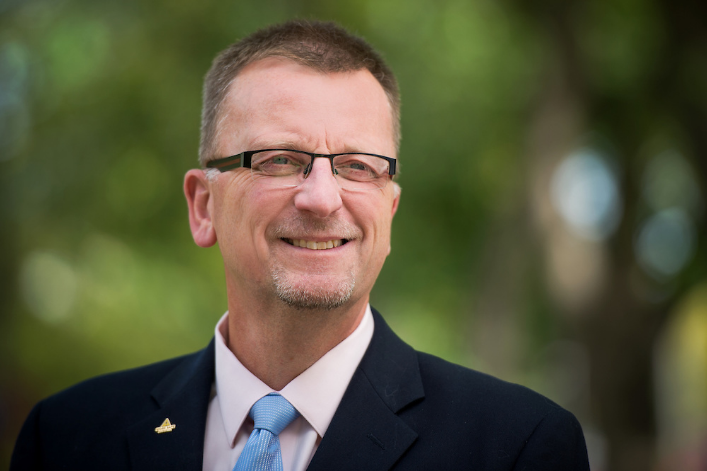
Andrew Sharman, our new vice-president (facilities and operations), came to the University of Alberta following several years with the Government of Alberta, and a 22-year career in the British Army. At first glance, these positions seem disparate — until Sharman explains how his career landed him and his wife, Yvonne, in Alberta, how skillsets like disaster response have spanned his professional transitions, and how an MSc in logistics management ties together his diverse experiences.
I sat down with Andrew Sharman to talk about his winding career path, the move to Alberta, his new role at the U of A, and… bomb disposal? Yes, that fits in, too.
You started September 1, 2016. What has been the highlight experience to date?
Meeting the team, I think. Getting out and seeing people is good; it’s what I like to do. I want to get to know the team better, and look at where our challenges are.
What is your overall impression of the role so far?
I think the key bit is: how do we safeguard the assets we have? How do we get more value for the money? And how do I help the team achieve that with as easy a time as possible? There are a lot of wants out there. What we need to do is cut to the true needs.
What do you have on the go right now?
We’re developing a capital plan for our whole inventory of ancillary operations. So: what does that look like for parking, hospitality, and residence? What are the anticipated costs, and what are the priorities? That includes a marketing plan for our residences, because of the challenges with fill rates.
We’ve got some challenges with the meal plan to work on. I’ve been meeting with students, and that’s my plan: to meet with more students to get one-on-one feedback.
Are there any campus infrastructure projects on your agenda?
We’re actually meeting to try to do some more work on Dent/Pharm, in case that gets funding. I continue to work with Dean Mummery over the Twin Arenas. Maskwa House is still at the top of mind. Plus, we’ve got a meeting on how we invest our infrastructure maintenance money as well, looking at strategies for the next couple of years.
You came from the provincial government. Can you briefly describe your role there?
[My role] morphed because of a change of premier in 2011, but I basically had the labour portfolio. Then when the floods hit [in 2013], I led the flood response for human services. And after that, I managed the cabinet office for 16 months for three premiers before I moved to Infrastructure.
Had you been involved in disaster response before the floods?
In my time in the military I’ve done a lot of that sort of thing. When I was in London for two years, we managed the crisis management centre. It’s all useful experience for the future.
You completed your degree in “Defence Logistics Management.” Can you explain what that is?
It’s a supply chain management degree. Because I did it through the military, they wanted to put a defence spin on it. But I did it out of Cranfield, which is a world leader in supply chain management. I’ve been in logistics for all of my career.
And you also spent some time on the bomb disposal unit?
As a young lieutenant in my old corps, you had to specialize in something before you made the rank of captain. I ended up in the ammunition world as an ammunition tech. So [bomb disposal] was part of our trade. I spent 6 months in Northern Ireland. It’s a young man’s game — I wouldn’t go back and do it now.
In 2002 you were posted to Suffield, Alberta and you realized that this was a place you wanted to return to. What drew you back to Alberta?
I’d come out just before New Years ’96 to ski. I didn’t expect to come back out to Suffield, but when we came out we made the most of it. We loved the place. We loved Canada. While we were here, [Yvonne and I] bought a house down in Cochrane on the golf course and thought, “Why not? We’ll rent it out, and we’ll come and live in it in 5 or 6 years.” Two and a bit years later we were back, and I got a job in Edmonton. I just loved the people in Alberta, loved the province, loved the country.
Was the transition to civilian logistics management in the provincial government difficult?
Not really, in a way, because it’s all about leadership. It’s a matter of asking: where are the priorities at any one time? Like it is here — this portfolio is incredibly broad.
What’s on your radar for your first year as VP?
Working with President Turpin, I’d like to help to move the agenda with the Government of Alberta to get some capital funding, so we can better utilize some of the assets we’ve got. And then also working with the deans, and with Provost Dew and the team, too, to look at where the priorities are. And truly ask, ‘Can we do it differently? Can we better use what we’ve got? Are there opportunities for some more limited investment?’ Because I think we’re in that sort of period now. So the question now is: how can we work together to really look at the hot spots? And where can we do a bit of give-and-take with each other, too, to try and make things better for everybody?
This interview has been edited for length and clarity.